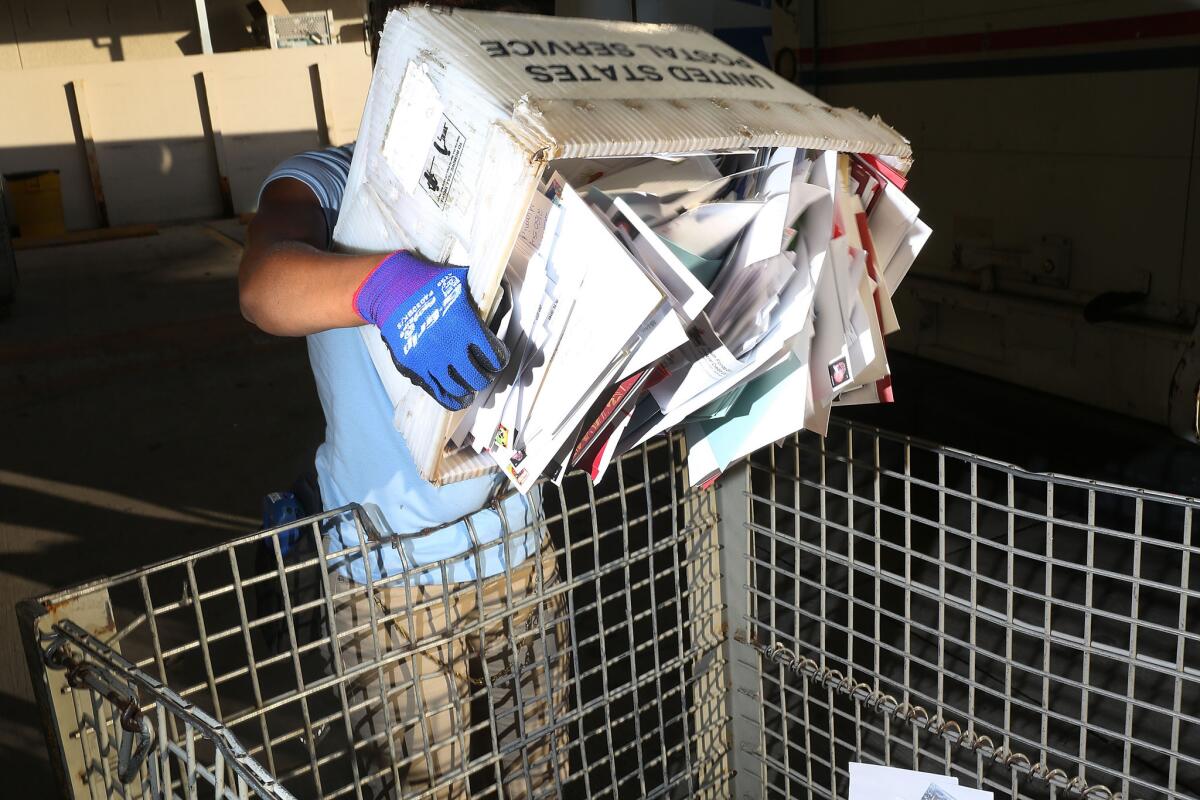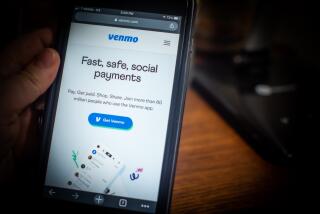Advocates push for the U.S. Postal Service to offer basic banking

The Great Recession has led to calls for the revival of postal banks as many cash-strapped households have been forced to seek payday loans and other alternative financial products.
reporting from Washington — Until the late 1960s, you could walk into a post office and deposit money in a savings account at the same time that you bought stamps or mailed packages.
An outgrowth of the financial panic of 1907, the no-frills postal bank surged in popularity during the Great Depression. But as commercial banks expanded and offered higher interest rates, the United States Postal Savings System became as outdated as a black-and-white movie.
Now, in the wake of another financial crisis, there’s a new push for the U.S. Postal Service to deliver basic banking services again.
The effort is led by consumer advocates, financial reform groups, postal labor unions and some leading liberals, such as Democratic presidential candidate Sen. Bernie Sanders (I-Vt.) and Sen. Elizabeth Warren (D-Mass.). They say that offering services such as paycheck cashing, bill payment and free ATMs would provide cash-strapped consumers with an affordable alternative to payday, auto-title and other short-term loans that have been criticized for high fees.
“We have millions and millions of low-income people who have to go to these payday lenders and pay outrageous interest rates. They’re getting ripped off right and left,” Sanders said on ABC’s “Jimmy Kimmel Live” in October.
“We can have our Postal Service provide modest banking to low-income people where they can cash their checks and they can do banking,” Sanders said. “I think it will help the post office and it will help millions of low-income people.”
The Postal Service’s inspector general’s office agrees. It estimates that expanding financial services beyond the current limited offerings, which include money orders and international funds transfers, could pump $8.9 billion a year into the financially struggling agency.
“The Postal Service has a public mission to serve citizens and support the growth of commerce,” the inspector general’s office said in a report last spring that presented five potential approaches for expanded banking services. “And while it is required to cover its costs, profit is not its key motive.”
See more of our top stories on Facebook >>
The American Postal Workers Union has formed a coalition, the Campaign for Postal Banking, that in December delivered a petition with more than 150,000 signatures to Deputy Postmaster General Ronald A. Stroman urging the agency to expand its financial offerings.
“Big banks are turning their backs on families,” union President Mark Dimondstein said. “Without bank accounts, they fall prey to predatory lenders.”
Postmaster General Megan J. Brennan hasn’t ruled out the idea of expanded banking services after her predecessor dismissed the suggestion in January as he headed into retirement. But she has some reservations.
“While we currently provide our customers with certain financial services, including money orders, electronic funds transfers and cashing of U.S. Treasury checks, our core function is not banking,” the agency said in a written statement.
There’s a sense that the post office is a dinosaur, but it’s not a shark.
— Mehrsa Baradaran, professor, University of Georgia
The service said it has an “infrastructure that is not ideal as a banking platform,” and cited a decline in visits to post offices. Plus, any investments outside of its core function of mail delivery “will likely be scrutinized from both public policy and regulatory perspectives,” the agency added.
The Postal Service is an independent agency that since 1971 has been required to rely on sales of stamps and other services to pay for its operations. But the growth of the Internet and competition from private shippers, such as FedEx Corp. and UPS, have taken a major toll on the agency’s finances.
After peaking in 2006, total mail handled by the Postal Service has declined 27%. That has led to budget deficits, exacerbated by a congressional requirement to pre-fund retirement benefits for its workers, that have forced the agency to borrow up to its allowable limit of $15 billion from the U.S. Treasury.
Expanded financial services offer “the single best opportunity for new revenue,” according to the inspector general’s office.
It’s not a far-fetched idea. Post offices in many other nations, including Britain, France, China and Japan, also serve as banks. And from 1911 to 1967, the United States Postal Savings System offered accounts with annual interest capped at 2%, to reduce competition with commercial banks.
Deposits at U.S. postal banks surged during the Great Depression and World War II, when many consumers viewed the accounts as more secure than those in commercial banks. But as those banks opened more branches and increased interest rates after the war, the postal banking system fell out of favor and the federal government shut it down.
The Great Recession has led to calls for the revival of postal banks as many cash-strapped households have been forced to seek payday loans and other alternative financial products.
A Federal Deposit Insurance Corp. survey found that about 9.6 million households in 2013 had no one with a bank account. An additional 24.8 million households had accounts but also used alternative financial services, such as payday loans.
“It’s harder for people with less money to use their money, and much more expensive,” said Mehrsa Baradaran, a University of Georgia professor and author of the book “How the Other Half Banks: Exclusion, Exploitation and the Threat to Democracy.”
Many poor areas lack bank branches, but most communities have a post office, said Katherine Isaac, a consultant to the postal workers union who has been organizing the Campaign for Postal Banking.
“Even if we put all the payday lenders out of business, there’s a concern that there’s still no place to go,” Isaac said. “The banks aren’t there. They’ve abandoned those communities. But the post office is there.”
The Postal Service is the most popular federal agency — 84% of respondents have a positive view of it, according to a recent Pew Research Center poll.
“I would guess that a lot of people would trust the post office teller with their money more than these Wall Street traders,” said Baradaran, an advocate for postal banks. “There’s a sense that the post office is a dinosaur, but it’s not a shark.”
Congress would have to pass legislation allowing post offices to take deposits and make loans. But the Postal Service could use existing authority to increase some offerings, such as expanding check cashing to include other government and payroll checks and broadening money orders into bill payment service, supporters said.
“This is not a cash cow for the post office,” Baradaran said. “But it could save them.”
ALSO
Transforming the end of the 2 Freeway could be the beginning of a new L.A.
2-car crash in Ontario kills 5, including a 6-year-old boy
Advocates push for the U.S. Postal Service to offer basic banking
More to Read
Inside the business of entertainment
The Wide Shot brings you news, analysis and insights on everything from streaming wars to production — and what it all means for the future.
You may occasionally receive promotional content from the Los Angeles Times.











